
Does your organization have the right cybersecurity controls in place? Does everyone understand their importance? Here are some of the more common controls successful cybersecurity strategies include.
By Robert Barresi, Enterprise Architect
Cybersecurity cannot be the responsibility of just security experts. The entire organization must be involved to keep information, employees, and external stakeholders secure. This means more than just following standard procedure. It means all employees should understand security controls, at least at a high level. Does your organization have the right controls in place? Does everyone understand their importance? Here are some of the more common controls successful cybersecurity strategies include.
Software Defined Perimeter (SDP) architecture to prevent and/or minimize network intrusions
SDP architecture is comprised of two components, hosts and controllers. The SDP hosts can initiate connections or accept connections managed by the controllers to separate channels of communications. There are various models that determine the design of this network. These models include client to gateway, client to server, server to server, or other configurations.
What you should know: SDP architecture is designed to help keep bad actors out of the network and maintain data security.
Zero Trust architecture to incorporate a model of never trust, always authorize
Zero Trust is defined by a set of security controls using strict identity verification by every person or entity to access a network or host, whether they originate from internal or external sources. Zero Trust architectures are essential to SDPs to ensure proper management and handling of access and data within a network and for external connectivity and communications.
What you should know: Zero Trust means everyone must be identified and present the right credentials to access networks and data, no exceptions.
User Account Control (UAC) to manage user access and authentication to services, systems, and data
UAC determines the access of a user to a system, service, or application through a security model layer encompassing user access control lists, domain, and/or access control policies. This includes user and role-based access. User-based access requires user authentication at the individual level via a username and password that could include a multi factor model authentication with single sign on (SSO). The role-based access is another layer comprised of groups that the user may access through group permissions.
What you should know: Your access to the system and data is determined by your role and function in the organization. You will need to use your username and password to verify your identity prior to using the network.
Endpoint Security protection on system networks to secure devices
Endpoint security is protection of networks comprised of directly or remotely connected devices, such as servers, workstations, laptop, tablets, and others.
What you should know: The endpoint protection manages a set of rules and standards that each device on the network must follow to ensure proper use of the devices, restricting use that could expose the device and/or network to vulnerabilities.
AI, ML, and DL to provide predictive modeling of cyber threats
Cybersecurity using artificial intelligence (AI), machine learning (ML), and deep learning (DL) can evaluate data through analysis of malicious data to learn what is considered good and bad. AI, ML, and DL processes can be replicated and automated.
What you should know: These emerging technologies can automatically detect when an anomaly occurs, such as new malware.
Code analysis to ensure quality and security
Code analysis, security, and quality are essential to any development activities and/or process, since these provide a scan for code related vulnerabilities from bad code and practices that expose applications and software to threats. Secure code will help prevent cyberattacks, as it removes the vulnerabilities many activities rely on.
What you should know: Code analysis is critical because malicious pieces of computer code and applications can damage your computer, mobile devices, and more, as well as steal your personal or financial information.
When organizations are missing any of these controls, all stakeholders are at risk. If your federal agency is questioning its approach to cybersecurity, reach out to Octo to discuss designing and implementing a plan that will protect your leadership, employees, and the public.


